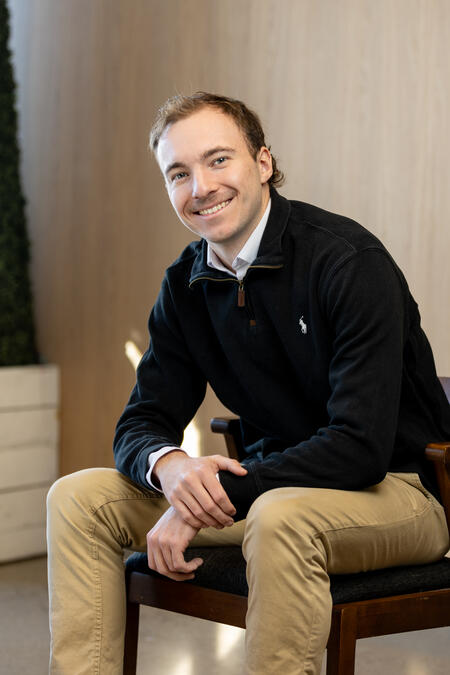
Simon Robitaille
QC
Canada
My name is Simon, I am 22 years old, and I study business administration at university. I have always been very athletic: skiing in the winter, cycling in the summer, weight training at the gym, golf, and more. In short, staying active and keeping in shape has always been at the top of my priority list.
In September 2021, I had just turned 20. I was in peak physical shape, but I constantly felt tired. This feeling grew stronger day by day to the point where I had to reduce the amount of physical activity I was doing. As the weeks went by, I became more and more fatigued and struggled to get through my school days.
In November, I started experiencing night sweats, and my girlfriend noticed a lump in my neck, just above my collarbone. That’s when the worry set in. We immediately scheduled a doctor's appointment to see what was going on. I finally saw the doctor in December, and she ordered blood tests. The results came back showing abnormally high white blood cell counts, and the tests indicated that I had mononucleosis. However, the extraordinary doctor I met at that time was not reassured and decided to continue monitoring my case to see if the swollen lymph nodes in my neck would decrease. It’s important to note that the serology of mononucleosis is the same as that of Hodgkin's lymphoma. I was advised to rest and watch for other symptoms.
In February, I returned to the doctor with the same symptoms. She decided to request a biopsy, despite the objection of an oncologist she had consulted, who was convinced that it was simply a more severe-than-usual case of mononucleosis.
The process moved fairly quickly. I had a biopsy on March 8, 2022, and on March 22, I received confirmation that requesting a biopsy had been the right decision—I had Hodgkin’s lymphoma. In the following days, I underwent a PET scan, which confirmed that the disease was at stage 4 and that I would need chemotherapy.
At the beginning of April, I started a chemotherapy regimen consisting of 12 treatments called “ABVD.” After just three treatments, I was already feeling much better, and my symptoms were gradually disappearing. I completed my 12-treatment cycle on September 16, 2022. I was completely cured and officially in remission. I could finally resume my normal life and begin my recovery.
In September 2022, I traveled to Morocco with my family to celebrate the end of what had been an extremely difficult year for me. During the trip, I noticed that every time I drank alcohol, I experienced spasms in my lower back. This was a symptom I had before starting treatment, but I didn’t think much of it. When I returned, I mentioned it to my oncologist. He wasn’t concerned, especially since my bloodwork looked excellent.
I resumed school for the winter semester, but I noticed that the symptom persisted every time I had a drink, becoming even more painful. It got so bad that I decided to stop drinking altogether. At my quarterly follow-up in April 2023, I insisted on getting a PET scan, even though my oncologist wasn’t worried about my symptom, as there were no other signs of the disease. My overall health was excellent, and my bloodwork was normal.
Eventually, I had the scan and met with my oncologist a few days later, on May 8. He informed me that my intuition had been right—I had done well to request the scan because the disease had relapsed. I was back to square one, and the cancer was again at stage 4. He explained that I would need to undergo an even more aggressive treatment called “GDP” to eliminate the disease and that I would later need to be hospitalized for nearly a month for an autologous stem cell transplant.
I began the pre-transplant treatment, which made me very sick. After two cycles, I had another scan, only to find out that the treatment wasn’t working and that the disease had progressed. As a result, my hospital admission, initially scheduled for August, was postponed by three months, and I started a promising new monoclonal antibody treatment called “Brentuximab.” After three treatments, the scan showed that the therapy was highly effective—the disease had completely disappeared, and I was ready for the stem cell transplant.
I was admitted to the hospital on October 3 for the transplant. I underwent 11 chemotherapy treatments over six days, followed by the transplant and a few days of waiting to recover from neutropenia. Everything went smoothly, without complications. I was the only patient fit enough to walk around the transplant ward. I was discharged after just 20 days—a record for the transplant unit at Hôtel-Dieu de Québec. To be fair, I had arrived at the hospital in good shape, having managed to play 65 rounds of golf over the summer despite my treatments, including 55 rounds where I walked all 18 holes.
Since my discharge in October 2023, I have resumed training and continued the antibody treatment that put me into remission to increase my chances of preventing a relapse.
In total, my two battles with cancer have amounted to 37 treatments over two years. That means a lot of needles, a lot of appointments, and a lot of stress for me and my loved ones.
Now, I’m challenging myself to participate in a sprint triathlon on June 9 in Laval. It’s a challenge I will take on between two treatments. I’ve been training for this event since February. A sprint triathlon consists of a 750m swim, a 20km bike ride, and a 5km run. I’m competing in this event alongside this year’s fundraising campaign, and I want to prove to myself that it’s possible to achieve great things—even between chemotherapy treatments! I also want to give hope to anyone who may one day undergo a stem cell transplant.
